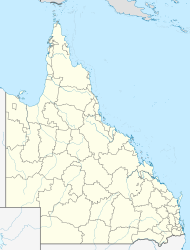world.wikisort.org - Australia
Kennedy is a coastal locality in the Cassowary Coast Region, Queensland, Australia.[2] In the 2016 census, Kennedy had a population of 161 people.[3]
| Kennedy Queensland | |||||||||||||||
|---|---|---|---|---|---|---|---|---|---|---|---|---|---|---|---|
 Kennedy | |||||||||||||||
| Coordinates | 18.1933°S 145.9633°E | ||||||||||||||
| Population | 136 (SAL 2021)[1] | ||||||||||||||
| Postcode(s) | 4816 | ||||||||||||||
| Area | 99.6 km2 (38.5 sq mi) | ||||||||||||||
| Location |
| ||||||||||||||
| LGA(s) | Cassowary Coast Region | ||||||||||||||
| State electorate(s) | Hinchinbrook | ||||||||||||||
| Federal division(s) | Kennedy | ||||||||||||||
| |||||||||||||||
Geography
Kennedy is on the coast with the Coral Sea forming its eastern boundary. The Bruce Highway passes through the locality from south to north. The North Coast railway line also passes through the locality from south to north, just to the west of the highway. The locality is served by the Kennedy railway station.[4]
The eastern and coastal part of the locality is within the Girramay National Park. Areas in the west of the locality are part of the Cardwell State Forest. The remaining land is predominantly freeland used for farming. The eastern part of the locality and the farmland is mostly at sea level but rises to 500 metres above sea level in the north-west of the locality in the foothills of nearby Mount Carruchan.[4]
History
The locality was named after the Kennedy railway station,[2] which was originally the Mulgan railway station until it was renamed in 20 February 1926 after the explorer Edmund Kennedy.[5]
Kennedy Creek Provisional School opened on 14 March 1927, becoming Kennedy Creek State School on 1 November 1944. It was renamed Kennedy State School on 19 February 1945.[6]
In the 2006 census, Kennedy had a population of 312 people.[7]
Education
Kennedy State School is a government primary (Prep-6) school for boys and girls at 161 Kennedy Creek Road (18.2092°S 145.9421°E).[8][9] In 2017, the school had an enrolment of 21 students with 4 teachers (3 full-time equivalent) and 7 non-teaching staff (4 full-time equivalent).[10]
References
- Australian Bureau of Statistics (28 June 2022). "Kennedy (Suburb and Locality)". Australian Census 2021 QuickStats. Retrieved 28 June 2022.
- "Kennedy – locality (entry 45716)". Queensland Place Names. Queensland Government. Retrieved 23 January 2017.
- Australian Bureau of Statistics (27 June 2017). "Kennedy (SSC)". 2016 Census QuickStats. Retrieved 20 October 2018.
- "Queensland Globe". State of Queensland. Retrieved 23 January 2017.
- "Kennedy – railway station (entry 17944)". Queensland Place Names. Queensland Government. Retrieved 23 January 2017.
- Queensland Family History Society (2010), Queensland schools past and present (Version 1.01 ed.), Queensland Family History Society, ISBN 978-1-921171-26-0
- Australian Bureau of Statistics (25 October 2007). "Kennedy (SSC)". 2006 Census QuickStats. Retrieved 23 January 2017.
- "State and non-state school details". Queensland Government. 9 July 2018. Archived from the original on 21 November 2018. Retrieved 21 November 2018.
- "Kennedy State School". Retrieved 21 November 2018.
- "ACARA School Profile 2017". Archived from the original on 22 November 2018. Retrieved 22 November 2018.
Другой контент может иметь иную лицензию. Перед использованием материалов сайта WikiSort.org внимательно изучите правила лицензирования конкретных элементов наполнения сайта.
WikiSort.org - проект по пересортировке и дополнению контента Википедии